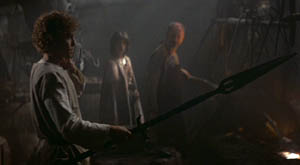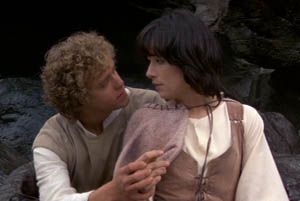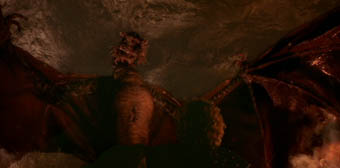|
 Dragonslayer is one of those lost gems, or at least semiprecious stones, from the realm of early-'80s fantasy, and it fares better than most. At a time before fantasy became respectable, it nicely managed to avoid the trap into which most similarly-themed films of its time fell, that being the conviction that they must have an undercurrent of silliness; even Ridley Scott's gorgeously lush Legend couldn't escape the bumbling sidekicks and cartoonish goblins. For the most part, Dragonslayer plays things straight, what things there are-the plot isn't especially complicated. Yet it functions better than it likely would if the film was made in modern times, although what is often referred to as "restraint" in older films many times was actually more properly described as "lack of money or technical ability." Galen is the ambitious apprentice to the great sorcerer Ulrich, somewhere in the Middle Ages. One day a group of emissaries-unofficial, as it turns out-from a nearby kingdom arrives to seek help with a troublesome dragon. Twice a year a virgin must be sacrificed to keep the beast from sending the whole land into flaming oblivion; how the dragon can tell a virgin from a total slut, and why it should care, are issues such stories never really address. Ulrich, however, isn't long for this world, and believing he has inherited his master's legacy, Galen determines to accomplish the task on his own. Not everyone wants to see Galen undertake the mission, though, and as we will see, they have good reason. 
The film was shot largely on location, and it shows. This is no idealized medieval world, with knights in gleaming armor and maidens in billowing silk gowns. Most everyone, including the king's own servants, looks rather unkempt and as if a bath is but a distant memory. A pall of despair hangs over the land. Even the likeable characters are capable of the most casual hypocrisy in the name of self-preservation. Galen's love interest, Valarian, has lived disguised as a boy for her whole life to avoid the sacrifice lottery, outing herself when she mistakenly believes the dragon to be dead. She bitterly complains that the rich have paid bribes to exempt their daughters from the lottery, her own cheating notwithstanding. The king has deliberately left his own daughter out ever since she reached maturity, but what father wouldn't? When the princess seems doomed to become the dragon's next victim, Galen determines to save her, running afoul of Tyrion, captain of the king's guards, in the process. Tyrion is an interesting character, more subtley drawn than most of his sort. He's brusque and not a very nice man, but while we're obviously not supposed to like him, it's hard not to see his point. Galen's attempts to kill the dragon have thus far only succeeded in further provoking the creature, whose retaliation against the kingdom calls to mind London during the Blitz. 
All of this brings us to the matter of the dragon itself. The winged monster known as Vermithrax Pejorative was, in its day, far and away the best screen dragon ever created, earning the film an Oscar nomination for visual effects. Its effectiveness as an adversary is partly due to its slow and ominous buildup; like the shark in Jaws, we don't get a good look at the dragon until the film is more than halfway over. When we do finally see it, it's a real event. Utilizing a then-new process known as Go-Motion, which eliminated the stacatto look of traditional stop-motion animation, Vermithrax comes to life as a convicingly real creature in a way that wouldn't be topped for another decade. One would never guess that the image on the screen came from a puppet that was only around a foot long, though the photochemical compositing gives away the film's age, opticals of that time being very much a hit-or-miss prospect in terms of efficacy. The film's biggest stumbling block is the fact that as a hero, Galen seems somewhat lacking in clear definition. Peter MacNicol feels a little too '80s in general, but that aside, the film never seems certain just how much of a wizard he really is. He causes a huge avalanche and seems to have mastered teleportation (unless he was just faking those smoky materializations), but cannot manage to open his cell door when the king has him imprisoned. He also doesn't really play a big enough part in the dragon's eventual defeat (sorry to spoil it for all of those who thought the dragon might have survived the film), either physically or emotionally, for us to honestly feel like he's gone on a proper hero's journey, and for some reason the movie sends us off with a truly goofy and overly-whimsical piece of music, at the last minute dredging up that tiresomely silly feel of Disneyfied fantasy it had done such an effective job of avoiding up until then. Perhaps Dragonslayer isn't what one might call a bona fide classic, but for anyone interested in fantasy without the pandering to children it so often is saddled with, it's worth your time. -review by Matt Murray
|
|
||||||||